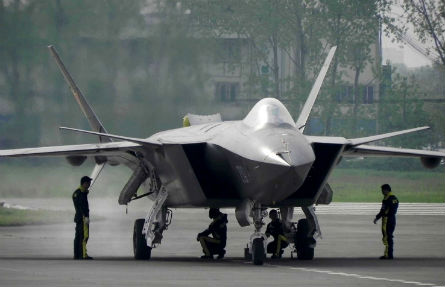A white paper published by Japan’s defence ministry has shed light on Tokyo’s views of military aviation developments in China and its decision earlier this year to select the Lockheed Martin F-35A for its 42-aircraft F-X requirement.
Tokyo’s annual Defense of Japan white paper discusses the nation’s strategic environment and security challenges. It makes specific mention of Beijing’s refurbishment of the former Soviet aircraft carrier Varyag (now undergoing sea trials) and its development of the Shenyang J-15 – a copy of the Sukhoi Su-33 – as clear evidence that China is building "capabilities to conduct operations in more distant areas".
"Based on these facts, it is believed that China is now earnestly advancing research and development on technologies necessary for possession of aircraft carriers," it says.
Tokyo is also concerned about Beijing’s growing force of Chengdu J-10s, Su-27s and Su-30s, as well as its investments in air-to-air refuelling and transport aircraft. It has observed more frequent Chinese intelligence-gathering flights near Japan, typically mounted by specialised variants of the Shaanxi Y-8 transport.
"These incidents indicate that Chinese aircraft are diversifying their flight patterns," the defence ministry says. "Judging from the modernisation of air forces and the activities by aircraft, it is believed that China is not only improving its air defence capabilities for its national territory, but also aiming to build up capabilities for air superiority and anti-surface and anti-ship attacks in areas which are as distant from China as possible, and improving long-range transportation capabilities. Further attention needs to be paid to these activities conducted by Chinese air forces."
The white paper dedicates several pages to the decision to obtain the F-35A over the Boeing F/A-18E/F Super Hornet and Eurofighter Typhoon in the F-X competition.
With regard to the threat environment that the new fighter will face, it cites "the emergence of high-performance fighter aircraft with excellent stealth capability and situation awareness capabilities".
This is clearly an allusion to Beijing’s developmental Chengdu J-20. Experts have questioned the ability of Chinese industry to create an advanced, stealthy fighter with capabilities such as supercruise and true sensor fusion. Nonetheless, general media has stoked a perception that the J-20 will be a rival to advanced western aircraft such as the Lockheed F-22. A Pentagon report in May suggested that the J-20 will be operational in 2018.
 |
|---|
Rex Features China's J-20 fighter could be operational as soon as 2018 |
The white paper lists four main criteria for Japan’s selection of the F-35A: performance; cost; industry participation; and logistical support.
It says that mathematical analysis indicated that the F-35A was the best performer and that it had obtained "a good balance of high scores in aircraft performance, fire control capability, electronic warfare capability, stealth target detection capability (air-to-ground attack capability, etc) and all other evaluation criteria."
Although the F-35A was second to the Super Hornet in purchase costs and second to the Typhoon in lifetime fuel costs, it actually won on a cost basis owing to the fact that it is already compatible with Japan’s air-to-air refuelling fleet. This indicates that the F-35A buy will obviate the requirement to modify the nation’s tankers.
All three types did well under industrial participation, while there was fierce competition under the logistical support criterion. Here, the F-35A won based on the aircraft’s ability to identify failures in greater detail, as well as "the function to indicate the expected time to replace components".
All three rivals came with a performance-based logistics programme, where the user only pays when pre-specified maintenance outcomes are achieved. All three had equal scores here.
Source: Flight International























